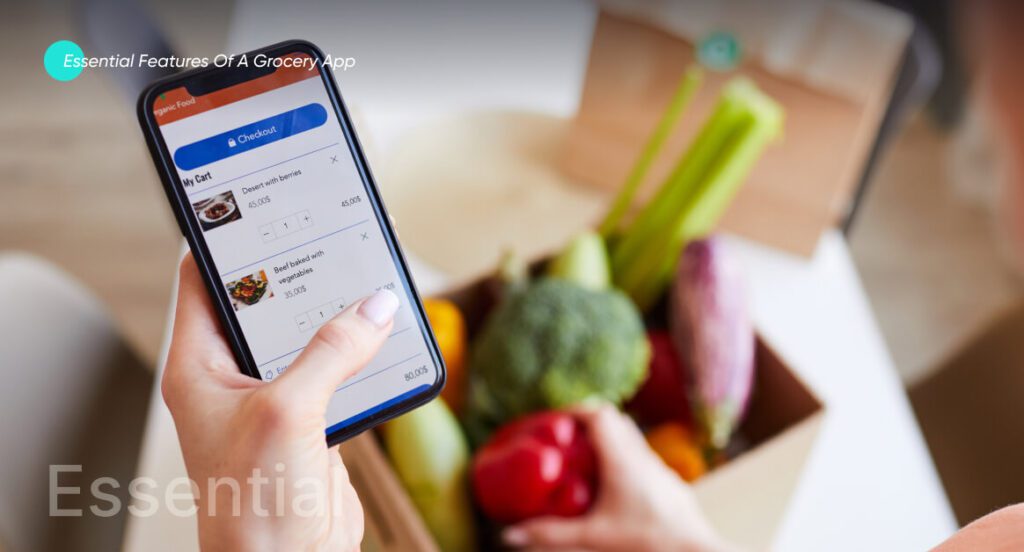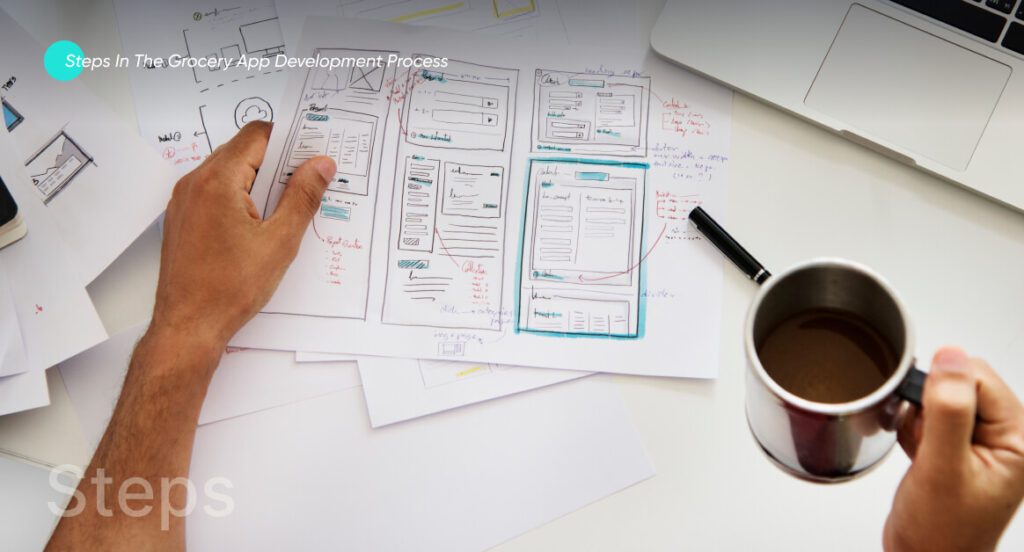A Guide On Grocery App Development
Grocery shopping was once a dreadful experience, but not anymore. Once burdened by long queues and the hassle of physically navigating crowded aisles, the transformative power of technology has changed how we shop for our groceries. Grocery app development allows us to effortlessly browse a vast array of products and swiftly add them to our virtual cart with a simple tap on the smartphone. The convenience of scheduling delivery or opting for curbside pickup has freed us from time and transportation constraints.
No longer is there a need to fret over forgotten items or tedious checkout processes; the grocery apps painstakingly organize our shopping lists and even suggest personalized recommendations. Grocery apps have revolutionized our shopping experience, empowering us to efficiently manage our household needs while simplifying and enhancing the shopping experience by providing convenience, time savings, and access to a wide range of products. Significantly, due to the rising demand for online grocery shopping, the global online grocery market is expected to grow from USD 42830 million in 2023 to USD 203290.
If you are a business owner and want to develop a grocery app, look no further. Read this article to discover the key steps involved in grocery app development.
Embrace convenience with our highly intuitive grocery app. Our Mobile App Developers are ready to asssit you! ![]()
What is a grocery app?
A grocery app allows shoppers to order groceries online. In this way, it saves time and money and offers convenience. There are two most well-known types of grocery apps, which include aggregators and marketplaces.
An aggregator grocery app connects users with various grocery stores, allowing them to compare products and prices, but it doesn’t handle inventory or delivery. A marketplace grocery app, on the other hand, creates a platform where multiple sellers, including grocery stores, can list and sell their products directly to consumers, often handling transactions and delivery. Aggregators connect users with existing stores, while marketplaces enable direct purchases from sellers within the platform.
What are the benefits of the grocery app?

Grocery delivery app development reaps numerous benefits for business owners and customers. They are cost-effective and offer convenience to customers while providing a great source of revenue for the app owners. Here are some of the vital benefits of grocery app development.
Effective order management and inventory
A grocery delivery app offers the benefit of adequate inventory and order management, providing real-time inventory tracking, improved order accuracy, efficient stock management, streamlined order fulfillment, demand forecasting, reduced manual effort, and superior customer experience. By integrating with the store’s inventory management system, the app ensures accurate stock levels and minimizes out-of-stock situations.
Customers can select items from a digital catalog, reducing errors and reviewing orders before finalizing them. Store owners can gain an understanding of customer preferences and demand patterns, optimizing stock levels and cutting costs. The app facilitates smooth order fulfillment processes, automates manual tasks, and provides customers clear visibility into their orders, boosting satisfaction and loyalty.
Better customer convenience
A grocery app offers better customer convenience in several ways. Firstly, it eliminates the need for customers to physically visit a grocery store, saving them time and physical effort. With just a few taps on their mobile devices, customers can browse various products, add them to their virtual carts, and complete the purchase from their homes.
Secondly, grocery apps often provide features like personalized recommendations, shopping lists, and saved preferences, making it easier for customers to find their desired items quickly and efficiently. In addition, these apps often offer flexible delivery options, allowing customers to choose their preferred time slots or opt for express delivery services, ensuring that groceries are conveniently delivered right to their doorstep.
Decreased overheads
A grocery delivery app development brings the crucial benefit of reduced overheads for customers and grocery retailers. For customers, the app eliminates the need to travel to physical stores – saving transportation costs and reducing the time spent shopping. Additionally, they can easily compare prices, take advantage of discounts and promotions, and seamlessly manage their budgets through the app’s features.
From a retailer’s perspective, a grocery app reduces the need for extensive physical store space, minimizing rental costs and operational expenses. It also streamlines inventory management, as real-time updates and analytics provided by the app enable better demand forecasting, reducing waste and improving stock levels.
Increased reach
A grocery app offers increased reach by allowing retailers to extend their market presence and access a broader customer base. Unlike conventional physical stores, a grocery app eliminates location constraints, allowing retailers to reach customers in different cities or countries. This expanded reach opens up new opportunities for business growth and customer acquisition.
Additionally, grocery apps often integrate features such as personalized recommendations and targeted marketing campaigns, enabling retailers to tailor their offerings to specific customer preferences and engage with a diversified pool of consumers.
By reaching customers beyond their physical store boundaries, grocery apps broaden brand visibility, increase customer engagement, and ultimately drive sales, providing retailers with a valuable competitive advantage.
Enhanced customer engagement
A grocery app offers enhanced customer engagement through various features and functionalities that promote active interaction and personalized experiences.
These apps provide a platform for retailers to engage with customers through push notifications, offering updates on new products, exclusive discounts, and customized offers based on individual shopping habits and preferences.
Additionally, grocery apps often have social sharing features, allowing customers to share their shopping experiences, recommend products, and provide feedback. The ability to quickly browse a wide range of products, access detailed product information, and read reviews further enhances customer engagement. Moreover, many grocery apps enlist loyalty programs, where customers can earn rewards and points for their purchases, stimulating customer loyalty.
Data-driven understanding
A grocery app development solution offers the benefit of data-driven understanding, providing retailers with vital information and analytics that can drive strategic decision-making. By accumulating and assessing customer data such as purchase history, browsing behavior, preferences, and demographics, grocery apps can generate functional insights into consumer trends, popular products, and buying patterns.
Retailers can use this data to enhance inventory management, forecast demand accurately, and tailor their product offerings to meet customer needs. Additionally, data-driven insights can help retailers personalize marketing campaigns, promotions, and recommendations, delivering customers a more targeted and smooth shopping experience.
Competitive edge
Grocery app development provides a significant competitive advantage by offering retailers an innovative and convenient platform to engage with customers, streamline operations, and differentiate themselves in the market. Retailers can benefit from personalized recommendations, targeted promotions, and seamless ordering processes. They can create a unique and enhanced shopping experience better than conventional physical stores.
Furthermore, gathering and analyzing customer data enables retailers to draw insights into consumer preferences and trends, empowering them to make data-driven decisions and optimize their offerings accordingly. In today’s digital age, with increased reach, reduced overheads, enhanced customer engagement, and data-driven insights, a grocery app enables retailers to stay ahead of the competition.
What are the essential features of a grocery app?

If you are a grocery app developer and want to create a quality, user-friendly app, remember to incorporate these must-have features.
User Registration and Profile:
The app allows users to create accounts, log in, and set up profiles. This feature enables personalized experiences, such as saved preferences, order history, and loyalty programs.
Shopping list
Users can create and manage shopping lists within the app. This feature helps organize items, streamline the shopping process, and allow for easy reordering of frequently purchased products.
Grocery catalogs
Organizing every product/item available in your grocery store in a catalog is essential. You can manage these products in categories (e.g., fruits/vegetables, drinks, personal care, and home care) with vital information such as photos, prices, descriptions, and recommendations.
Shopping cart
A shopping cart is an essential feature of your grocery app. It is where your customers will place the products/items they intend to purchase. Your shopping cart should feature add/remove options, indicate delivery, and complete your order options.
Discounts and promotions
Users can view current discounts, deals, and promotional offers within the app. This feature helps shoppers save money and stay informed about ongoing sales.
Personalized recommendations
Grocery apps often leverage user data to provide personalized recommendations based on previous purchases, shopping habits, and preferences. This feature enhances the shopping experience and encourages the exploration of new products.
Delivery Tracking
For home delivery orders, users can track the status and location of their deliveries in real time. This feature offers transparency and helps customers plan their schedules accordingly.
Payment options
Grocery apps support various payment methods, such as credit/debit cards, mobile wallets, and online payment gateways. Secure and convenient payment processing is an essential feature of any grocery app.
What are the essential steps in the grocery app development process?

Plan
The first stage in the grocery delivery app development involves the creation of a comprehensive business plan. This business plan will include the identification of your ideal customer. You will also need to conduct market research to grasp market competition and assess how to gain a competitive advantage. You also need to create a detailed plan highlighting your grocery app’s features, functionalities, and technology stack.
Prototype and wireframing
In the second stage, the wireframes for your grocery app are developed to ascertain the app’s structure. Similarly, the app’s user interface (UI) and user experience (UX) are designed alongside the creation of a prototype for testing the basic functionalities and gathering feedback for improvements.
Development
The development phase is the core stage of the grocery app development process. It begins with identifying the platforms and technologies and analyzing the feasibility of integrating with third-party services. This stage will also involve backend development, where you will establish server infrastructure and database systems, develop APIs, and implement data storage.
As for the front-end development, the UI will be created on frameworks like React Native and Flutter. Finally, core features are applied to the app alongside implementing navigation, screens, and interactive elements based on the wireframes and UI/UX designs.
Launch
At this last stage of the grocery app development solution, the Quality Assurance teams conduct detailed testing to ensure that the app works seamlessly and doesn’t contain bugs. Prepare the app for deployment on app stores (Apple App Store and Google Play Store). Finally, release the app and provide post-launch support and updates for the grocery app.
See our Latest Relevant Exploration Strategies for Effective M-Commerce App Development
![]()
FAQs
The development time for a grocery app can vary depending on factors such as complexity, desired features, platform (iOS, Android, or both), and the development team’s expertise. Generally, developing a functional grocery app can take anywhere from 2 to 6 months. However, more complex features or extensive customization may extend the development timeline.
Developing a grocery app can benefit your business in several ways. It enables you to reach a more extensive customer base, provide a convenient shopping experience, increase customer loyalty, gather valuable customer data, and boost overall sales.
The grocery app market is highly competitive, with numerous apps vying for dominance. However, some leading grocery apps include Instacart, Amazon Fresh, Walmart Grocery, Costco, Carrefour, and Tesco.
You should target both iOS and Android platforms to reach a wider audience. You can achieve this by developing native apps for each platform or using cross-platform frameworks like React Native or Flutter.
You can monetize your grocery app through various methods, including charging a commission from grocery stores for each order placed through your app, in-app advertisements, premium subscriptions for additional features, and partnerships with brands for sponsored product placements.
The decision depends on your specific requirements and budget. Building a custom app from scratch gives you complete control over the features and design, but it can be time-consuming and costly. Pre-built solutions, also known as white-label apps, offer a quicker time-to-market and can be customized to some extent.
Gohar is a seasoned IT writer specializing in leading technologies. He holds a Diploma and Bachelor's degree from the University of London, with professional experience spanning over five years in the IT sector. His expertise involves a keen focus on mobile applications, web apps, blockchain, content management systems, e-commerce, and fintech. Beyond the professional field, Gohar is an avid reader and reads extensively about emerging and innovative technologies.